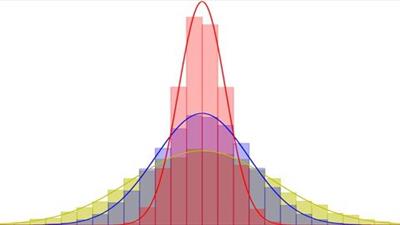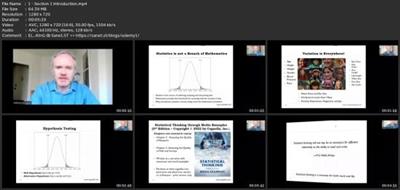
Statistical Thinking For Data Analysis
Published 4/2023
MP4 | Video: h264, 1280x720 | Audio: AAC, 44.1 KHz
Language: English | Size: 2.52 GB | Duration: 5h 9m
Learn to think statistically through real world examples[/center]
What you'll learn
Learn what statistical calculations mean and not simply how to calculate them
Gain a solid foundational understanding of the fundamentals of data analysis
Understand how to interpret data visualizations and summary statistics
Understand how to interpret confidence intervals for making decisions using data
Understand the process of hypothesis testing for making decisions using data
Understand the strengths and limitations of hypothesis testing and how it can be misused
Build and interpret linear regression models with confidence
Learn the statistical concepts through media, research and real-world data examples
Requirements
Basic Arithmetic. No other background knowledge required
Description
Course DescriptionDevelop a solid foundation in statistical thinking, necessary for anyone working in a data-driven field. Conduct data analysis, interpret and communicate the results to your colleagues with confidence. Stand out as a data scientist by truly understanding how and what it means to think statistically.Learn How to Think Statistically About Data Analysis Results· Learn how to think statistically as opposed to simply learning the mathematics of statistics· Learn how to visualize, measure, minimize and reason with variation in data· Learn how to reason with the variation in sample statistics in order to make decisions· Understand the reasoning hypothesis testing and what p-values really mean· Understand linear regression and gain the insight "All models are wrong, but some are useful"· Engrain your understanding through media, research and real-world data examplesStand Out By Understanding What Your Data Analysis Really MeansKnowing how to interpret and communicate the results of data analysis has become an absolute necessity for employees of numerous types of businesses and organizations working with data. However, many students leave introductory statistics courses (and college) without a solid understanding of what the statistical calculations, like p-values, actually mean.This course is for anyone who needs to be able to conduct data analysis and/or interpret the results of data analysis with confidence. The focus is on understanding and reasoning with the statistical calculations and not the calculations themselves. The use of media, research and real-world data examples makes the statistical concepts more engaging, palatable and relevant.Content OverviewThe course contains 36 lectures and 5 hours of content and requires no previous experience in data analysis. Statistical thinking is a necessary foundation for any science that involves the analysis of data. If you work with data in any capacity, you need to have a solid foundation in statistical thinking. Without it, you will always be on shaky ground, not exactly sure what the results of your data analysis actually mean.Statistical thinking begins with the question about the world of populations. We pursue answers to those questions using data and sample statistics. A sample statistic is an estimate of an unknown truth in a population of interest (known as a population parameter) .We will contrast the complexity of observational data where causal conclusions can't be made, due to what are known as confounding factors, with the power of randomized experiments to enable us to make causal conclusions about how the world works. Understanding the complexity of data and questioning the quality of your data is a important first step in becoming a good data analyst.We will learn how to measure the level of uncertainty in our statistical decision with regard to how the world works using probability. A p-value, the end result of the process of hypothesis testing used for decision making, is a conditional probability. Therefore, in this section, we will focus primarily on understanding what we mean by conditional probability.We will learn how to measure and reason with the variation in data through the interpretation of data visualizations and summary statistics. As random as the world of variation appears, order is often found in the variation of measurements, in the shape of the normal (probability) distribution or bell-shaped curve. We will become familiar with the characteristics of this curve and how to use it to calculate the probability of particular events occurring.This order in randomness (the bell-shaped curve) is also to be found in the distribution of sample statistics (known as the sampling distribution), around the unknown truth or population parameter. We will use this foundational framework, along with our sample statistic, to make decisions about the possible value of a population parameter of interest. A solid understanding of these concepts is an absolute necessity for understanding the reasoning of statistical analysis that we cover over the remainder of the course. We will reason with the sampling distribution to try and capture the population parameter within a range of plausible values known as a confidence interval. We will reason with the meaning of confidence intervals through real-world data and media examples. We will reason with the sampling distribution to learn a very powerful (but often misunderstood) process, for making decisions about the value of a population parameter, known as hypothesis testing. We will learn what a p-value and "statistical significance" really mean, plus gain a solid understanding of very important concepts like the power of the test. We will reason through the steps of hypothesis testing using real-world data and media examples. We will learn a powerful and versatile statistical technique known as linear regression, much used in both the field of Statistics and Data Science, for building statistical models that approximate the complex relationships between variables in the observational world of data. Once you gain the insight that "All models are wrong, but some are useful", you will have succeeded in this course and are truly a statistical thinker.Finally, we will look at how the process of hypothesis testing can be misused (or simply misunderstood) by researchers due to a lack of a solid foundation in statistical thinking. The course is based on the third edition of my textbook titled "Statistical Thinking through Media Examples" published by Cognella. It works very well as an armchair study as you work through the course lectures. It was written in a clear and concise narrative with numerous media, research and real-world data examples. This approach makes the statistical concepts more engaging, palatable and relevant.Chapter 2 and chapter 3 of the textbook are not covered in this course. In these chapters you learn how to critically access the quality of research including polls and surveys. We go beyond the news headlines to the source of the research to question the quality of the study design and data collected. No matter how good a statistical thinker you become, data analysis is built on data, so it is very important to understand the quality of the data the analysis is built upon.It is not necessary to purchase the book in order to succeed in this course. However, it provides strong support as you work through the lectures and a more complete learning experience.
Overview
Section 1: Introduction
Lecture 1 Section 1: Introduction
Section 2: Populations and Samples
Lecture 2 Data, Types of Variables, Datasets
Lecture 3 Examples - The MMR Vaccine - Autism Link, COVID Testing in NYC Population
Section 3: Types of Studies
Lecture 4 Randomized Experiments - Migraine Study Example
Lecture 5 Randomized Experiment - Hydroxychloroquine Study Example
Lecture 6 Observational Studies - Hydroxychloroquine Study Example
Section 4: Measuring Uncertainty with Probability
Lecture 7 What is Probability?
Lecture 8 Conditional Probability - Hospital Example
Lecture 9 Conditional Probability - Blood Pressure - Cholesterol Example
Lecture 10 Bayes Rule - Testing for Disease Example
Section 5: Visualizing and Summarizing Sample Data
Lecture 11 Histograms, Means and Standard Deviations - Climate Change and College Football
Lecture 12 The Normal Distribution and Z-Scores
Lecture 13 The Normal Distribution and Z-Scores - Blood Pressure Example
Section 6: Visualizing and Summarizing Sample Statistics
Lecture 14 Sample Proportion - Election Polling and Coin-Toss Example
Lecture 15 Sample Means - Height Example
Lecture 16 Sample Means - Pregnancy Duration Example
Section 7: Confidence Intervals
Lecture 17 Population Mean - Heart Disease Example
Lecture 18 Population Proportion - National Youth Fitness Survey and Election Polling
Lecture 19 Comparing Means - National Youth Fitness Survey Example
Section 8: Hypothesis Testing
Lecture 20 Population Proportion - Coin-Toss Example
Lecture 21 Population Mean - Height and Heart Disease Data Examples
Lecture 22 One-Sided versus Two-Sided Alternatives - Height and Heart Disease Data Examples
Lecture 23 What Does the P-value Really Mean?
Lecture 24 Comparing Means - National Youth Fitness Survey Example
Lecture 25 Comparing Means - College Football Study Example
Lecture 26 Comparing Proportions - Analysis of 2x2 Tables - National Youth Fitness Survey
Lecture 27 Comparing Proportions - Analysis of 2x2 Tables - The Power-Pose Study Example
Lecture 28 Types of Error and Power of the Test
Lecture 29 Types of Error and Power of the Test - Mask Study and Hydroxychloroquine Example
Section 9: Linear Regression
Lecture 30 Correlation - National Youth Fitness Survey Data Example
Lecture 31 The Line of Best Fit - COVID-19 and National Youth Fitness Survey Data Example
Lecture 32 Understanding How the Line of Best Fit is Chosen
Lecture 33 Statistical Inference for the Line of Best Fit - National Youth Fitness Survey
Lecture 34 Multiple Linear Regression - National Youth Fitness Survey Data Example
Section 10: Integrity in Research
Lecture 35 The Extra Sensory Perception and Power-Pose Studies
Lecture 36 The Vioxx Study - Oxycontin and The Opioid Epidemic
Students taking an introductory course in Statistics,Students who have taken more advanced courses in Statistics or Data Science who want a more solid foundational understanding in statistical thinking,Professionals working as data analysts of any kind who want to conduct, interpret and communicate of the results of data analysis• Professionals working as data analysts of any kind who want to conduct, interpret and communicate of the results of data analysis,Managers and executives who need to be able to read and understand data analysis reports,Professionals, like journalists and medical practitioners, who need to be able to read and assess the quality of research findings presented in journal articles,Anyone who wants or needs to develop their critical and statistical thinking skills
[align=center]
download скачать link
rapidgator.net:
https://rapidgator.net/file/ee3fd3450507fb7707f4c9975f9cf5fe/ekvvh.Statistical.Thinking.For.Data.Analysis.part1.rar.html https://rapidgator.net/file/3fafb85e08694d3f642691ddae08d99a/ekvvh.Statistical.Thinking.For.Data.Analysis.part2.rar.html https://rapidgator.net/file/170deaa0465f7ec96898f0aa01c78cbe/ekvvh.Statistical.Thinking.For.Data.Analysis.part3.rar.html
uploadgig.com:
https://uploadgig.com/file/download скачать/fDA962c3326a0a03/ekvvh.Statistical.Thinking.For.Data.Analysis.part1.rar https://uploadgig.com/file/download скачать/0831Af2fb6e8a914/ekvvh.Statistical.Thinking.For.Data.Analysis.part2.rar https://uploadgig.com/file/download скачать/783b7887c2f0Aa33/ekvvh.Statistical.Thinking.For.Data.Analysis.part3.rar
nitroflare.com:
https://nitroflare.com/view/DAEC548AAB64E0B/ekvvh.Statistical.Thinking.For.Data.Analysis.part1.rar https://nitroflare.com/view/C7A80A3EF387EA6/ekvvh.Statistical.Thinking.For.Data.Analysis.part2.rar https://nitroflare.com/view/F7CDB332C11AA43/ekvvh.Statistical.Thinking.For.Data.Analysis.part3.rar
1dl.net:
https://1dl.net/89cv9y8u1w8m/ekvvh.Statistical.Thinking.For.Data.Analysis.part1.rar https://1dl.net/uglqrchp2e6n/ekvvh.Statistical.Thinking.For.Data.Analysis.part2.rar https://1dl.net/ru2x23v7p709/ekvvh.Statistical.Thinking.For.Data.Analysis.part3.rar

